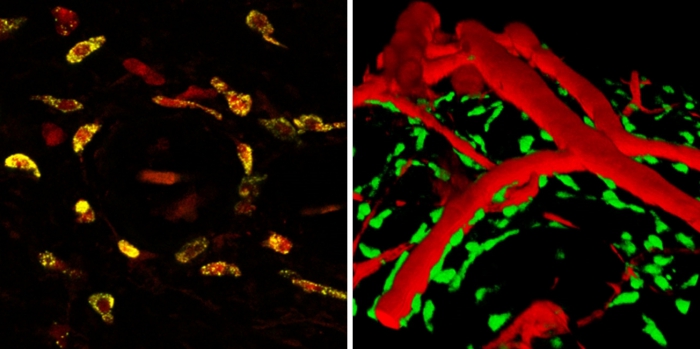Prof. Dr. sc. Andreas Müller
Director Research & Teaching
Prof. Dr. med. Dirk Reinhold
Director Diagnostics
More information on the research of the Dudeck group is available on the own webpages of the Dudeck lab.
A complex network of tissue-resident immune and non-immune cells realizes the integrity of a tissue, such as the skin, which is the first barrier against invading pathogens. These cells communicate with each other and maintain integrity through a balance of anti- and pro-inflammatory signals. Tissue-resident immune cells recognize the invasion of a pathogen or the breach of integrity through a wound communicate through increased pro-inflammatory signals. These lead ultimately to the activation of immune and non-immune cells (e.g. the blood vessel endothelial cells) and the recruitment of additional effector cells the innate and adaptive immune response (neutrophilic granulocytes, monocytes, T cells). The cells can communicate with each other either over a distance through soluble mediators or through direct physical interaction.
Our research group Immunoregulation deals with the intercellular communication of immune cells of the innate immune response. We primarily use the innovative technique of intravital 2-photon microscopy of transgenic mouse models, in which certain cells express fluorescent reporter proteins. In particular, non-invasive intravital microscopy of the skin enables us to watch the cells at work in real time and to track immune defense processes in the course of an inflammatory reaction up to tissue regeneration.

Left: The tissue-bound mast cells (red) in the skin of transgenic mast cell reporter mice with the typical intracellular granules (yellow). Right: Localization of the mast cells (green) in close proximity to the blood vessels (red) of the skin.
The focus of our working group is the investigation of the function of mast cells in immune defense processes and inflammatory reactions. Although mast cells are known to be effector cells of type I allergy, their role in maintaining tissue integrity and in the induction and regulation of innate and adaptive immunity has been poorly understood. Our work over the last few years has shown that mast cells play an important role as tissue-resident sentinel cells, which initiate the innate immune response and can also influence adaptive defence.
1. Influence of mast cells on vascular reactions and leukocyte recruitment
Mast cells are located very close to the blood vessels of the skin and initiate the early vascular response of an inflammatory process, particularly vasodilation and increased vascular permeability. We are currently investigating the role of mast cell-released TNF in leukocyte recruitment to the site of inflammation.
2. Intercellular dynamic interaction between mast cells and dendritic cells
Both mast cells and dendritic cells are tissue-resident sentinel cells in the skin and recognize invading pathogens or injuries. We have shown that during an inflammatory reaction in the skin there is a dynamic interaction of both cells. This interaction leads to a transfer of proteins (including the green fluorescent reporter protein, see Fig. 3) from dendritic cells to mast cells. As a result, mast cells are equipped with dendritic cell functions before the dendritic cells migrate into the draining lymph nodes as part of the immune response. We are now investigating how this interaction is initiated and what functional changes it triggers in mast cells and dendritic cells.

Left: During an inflammatory response, dendritic cells (green) deliver MHC class II complexes to mast cells (red) before migrating to the lymph nodes to activate T cells (blue). The mast cells remain in the skin and can activate the T cells, which migrate to the inflamed areas of the skin. (Scheme provided by A. Medyukhina). Right: Dynamic interaction between dendritic cell and mast cell. Intravital multiphoton microscopy of three dendritic cells (green) and one mast cell (red) during the inflammatory response in the skin. The mast cell also shows intracellular vesicles (yellow) with the green fluorescent protein transferred from the dendritic cells.
Prof. Dr. sc. Andreas Müller
Director Research & Teaching
Prof. Dr. med. Dirk Reinhold
Director Diagnostics
Prof. Dr. med. Dirk Reinhold
Tel: 0391-67-15857
dirk.reinhold@med.ovgu.de
Irena Osterland
Personal assisstant
Tel: 0391-67-15338
irena.osterland@med.ovgu.de
Dr. rer. nat. Martina Beyrau
Science management
Tel: 0391-67-24399
martina.beyrau@med.ovgu.de
Julia Grüber, M. Sc.
Administration M. Sc. Immunology
Tel.: +49 391 67-24387
julia.grueber@med.ovgu.d
Last Modification: 10.04.2024 - Contact Person: